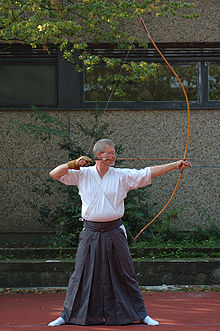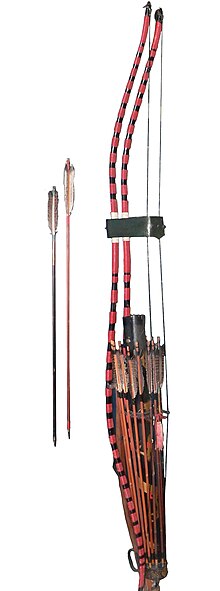Yumi
A yumi ( Japanese 弓 , kun reading : yumi , on reading : kyū ) is a Japanese bow . The most common variants are the long bow ( 大 弓 , daikyū , literally 'large bow') and the short bow ( 半 弓 , hankyū , literally 'half bow ').
The archery was one of the oldest martial arts of the Samurai . The bow was considered to be the embodiment of discipline and purity . The yumi is considered to be the longest known longbow worldwide.
history
Bows were used in Japan as early as the third century and were originally made from untreated wood. Developed from these early models, the longbow was one of the samurai's most feared weapons, with long range and penetrating power.
Kyūdō was already being practiced on traditional occasions in the eighth century and was one of the most important martial arts disciplines that a samurai had to learn. Longbows were the key weapon in every battle in feudal Japan for a long time. The samurai sought out an opposing archer in a fight and fought a kind of long-range combat duel instead of acting as a single troop. Even when the first firearms found their way into Japan in the middle of the 16th century , the bow did not lose its importance. Firearms required expensive gunpowder imported from England and were often unusable in the rain. Bows were far more reliable and, in the hands of a skilled archer, had approximately the same range at a higher rate of fire.
The Japanese bow developed into a label and a status symbol. Today the yumi is used as a means of concentration and is popular with all classes. The bow used in kyūdō today hardly differs from its historical model, the samurai longbow. The use of the long bow, the kyūdō (path of the bow), is still very popular today as a martial art and is one of the oldest of the traditional Japanese budō arts.
construction
For the Yumi a wooden core is glued with several layers of bamboo , then varnished and partially wrapped with rattan . Bows made from this composite material hold the tension much better than a simple wooden bow. The covering, i.e. the bowstring ( 弦 , tsuru ), consists of wax-coated hemp or bast fiber , which is attached to the body of the bow with silk tape; Traditionally, white silk ribbon was used at the bottom and red-colored ribbon at the top.
Typical of the longbow is its asymmetrical shape. The handle divides the bow into a short lower part and a considerably longer upper part, which means that these long bows can also be used from horseback; this form existed before horses were introduced in Japan. In addition, the vibration of the asymmetrical bow when shooting on the handle is significantly less, since the standing wave of vibration has a node on the handle. The length of a daikyu was based on the extension length , which was roughly half the height of the bushi (warrior). A distinction was made between the standard lengths Sansun-tsumari (2.12 m), Namisun (2.21 m), Nisun-nobi (2.27 m), Yonsun-nobi (2.33 m), and Rokusun-nobi (2.39 m) ) and Hassun-nobi (2.45 m). In addition to the long bow, there was a shorter version called a short bow, which was intended for use in limited space, e.g. B. indoors or between dense trees; also the Kago Hankyū , a miniature bow that could even be shot from a narrow litter .
Arrows
The arrows ( 矢 , ya ) consisted of a bamboo shaft, which was straightened in a hollow with strongly heated sand. Eagle , hawk , crane or peacock feathers were used for the fletching . Arrowheads were made by specially specialized blacksmiths. There were three main forms:
- A narrow, four-sided arrowhead, which was shaped after the model of a leaf and was named after it (a popular shape was e.g. sasa no ha 'bamboo leaf'); the narrow leaf shape was suitable for piercing an opponent's armor.
- Hirane , a spiked arrowhead with a thin leaf.
- Karimata , a forked shape.
quiver
The quiver ( 靫 , utsubo ) was made of Urushi- lacquered bamboo and had a flap on the bottom so that arrows could also be pulled down from the quiver.
Web links
Individual evidence
- ↑ a b Helen Adams: JAPANESE ARMS AND ARMOR , "Japanese Archery", Pitt Rivers Museum, 2007 (online PDF 356 MB) ( Memento from October 17, 2017 in the Internet Archive )


